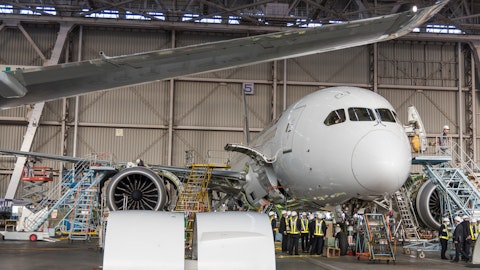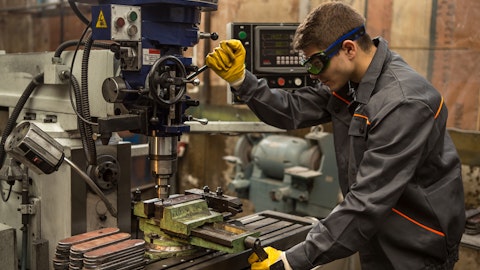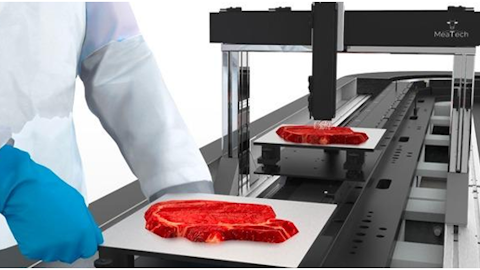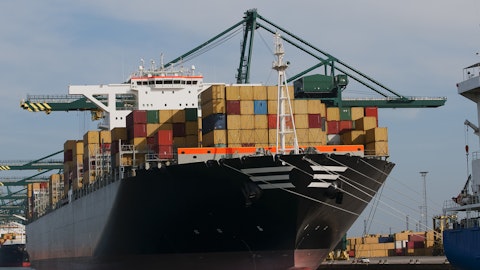Caterpillar Inc. (NYSE:CAT) Q2 2023 Earnings Call Transcript August 1, 2023
Caterpillar Inc. misses on earnings expectations. Reported EPS is $3.18 EPS, expectations were $4.58.
Operator: Ladies and gentlemen, welcome to the Second Quarter 2023 Caterpillar Earnings Conference Call. Please be advised that today’s conference is being recorded. I would now like to hand the conference over to your speaker today, Ryan Fiedler. Thank you. Please go ahead, sir.
Ryan Fiedler: Thanks, Abby, and good morning, everyone, and welcome to Caterpillar’s second quarter of 2023 earnings call. I’m Ryan Fiedler, Vice President of Investor Relations. Joining me today are Jim Umpleby, Chairman and CEO; Andrew Bonfield, Chief Financial Officer; Kyle Epley, Senior Vice President of the Global Finance Services Division; and Rob Rengel, Senior IR Manager. During our call, we’ll be discussing the second quarter earnings release we issued earlier today. You can find our slides, the news release and a webcast recap at investors.caterpillar.com under Events and Presentations. The content of this call is protected by U.S. and international copyright law. Any rebroadcast, retransmission, reproduction or distribution of all or part of this content without Caterpillar’s prior written permission is prohibited.
Moving to Slide 2. During our call today, we’ll make forward-looking statements, which are subject to risks and uncertainties. We’ll also make assumptions that could cause our actual results to be different than the information we’re sharing with you on this call. Please refer to our recent SEC filings and the forward-looking statements reminder in the news release for details on factors that individually or in aggregate, could cause our actual results to vary materially from our forecast. A detailed discussion of the many factors that we believe may have a material effect on our business on an ongoing basis is contained in our SEC filings. On today’s call, we’ll also refer to non-GAAP numbers. For a reconciliation of any non-GAAP numbers to the appropriate U.S. GAAP numbers, please see the appendix of the earnings call slides.
Now let’s turn to Slide 3 and turn the call over to our Chairman and CEO, Jim Umpleby.
James Umpleby: Thanks, Ryan. Good morning, everyone. Thank you for joining us. As we close out the first half of 2023, I want to recognize our global team for delivering a very strong second quarter. This included double-digit top-line growth, higher adjusted operating profit margin, record adjusted profit per share and robust ME&T free cash flow. Our results continued to reflect healthy demand across most end markets for our products and services. We remain focused on executing our strategy and continue to invest for long-term profitable growth. In today’s call, I’ll begin with my perspectives on our performance in the quarter. I’ll then provide some insights on our end markets. Lastly, I’ll provide an update on our sustainability journey.
It was another strong quarter. Sales and revenues increased 22% in the second quarter versus last year. Adjusted operating profit margin improved 21.3%, up sequentially and year-over-year. We also generated $2.6 billion of ME&T free cash flow in the quarter. Our second quarter results were better than we expected for sales and revenues, adjusted operating profit margin, and ME&T free cash flow. In addition, we ended the quarter with a healthy backlog of $30.7 billion. We continue to see improvement in the supply chain, which allowed us to increase production in the quarter. However, areas of challenge remain, particularly for large engines, which impacts energy and transportation and some of our larger machines. While we continue to closely monitor global macroeconomic conditions, we now expect our 2023 results to be better than we had previously anticipated.
Turning to Slide 4. In the second quarter of 2023, sales and revenues increased by 22% to $17.3 billion. This was primarily due to higher sales volume and price realization. Sales volumes were higher than we expected, largely due to an increase in dealer inventory relating to energy and transportation, which is supported by customer orders. We saw double-digit increases in sales and revenues in each of our three primary segments. Compared with the second quarter of 2022, overall sales to users increased 16%. For machines, which includes Construction Industries and Resource Industries, sales to users rose by 8%. Energy & Transportation was up 47%. Sales to users in Construction Industries were up 3%. North American sales to users increased and were better than expected as demand remained healthy for non-residential and residential construction.
Non-residential continue to benefit from government-related infrastructure and construction projects. Residential sales to users in North America also increased in the quarter. EAME saw lower sales to users due to weaker than expected market conditions in Europe. The Middle East continued to demonstrate strong construction activity. In Latin America and Asia/Pacific, sales to users declined in the quarter. In Resource Industries, sales to users increased 26%. In mining, sales to users increased, supported by commodities remaining above investment thresholds. Within heavy construction and quarry and aggregates, sales to users also increased, supported by growth for infrastructure-related projects. In Energy & Transportation, sales to users increased by 47% in the second quarter.
All applications saw higher sales to users in the quarter. Oil and gas sales to users benefited from strong sales of turbines and turbine-related services. We also saw continued strength in sales of reciprocating engines into oil and gas applications, such as Tier 4 dynamic gas blending, gas compression, and repowering active well servicing fleets. Power generation sales to users continued to remain positive due to favorable market conditions, including strong data center growth. Industrial and transportation sales to users also increased. Dealer inventories increased by $600 million in the quarter, led by energy and transportation. We are very comfortable with the total level of dealer inventory, which remains in the typical range. Adjusted operating profit margin increased to 21.3% in the second quarter as we saw improvements, both on a sequential and year-over-year basis.
Adjusted operating profit margin was better than we had anticipated, primarily due to better than expected volume growth and lower than expected manufacturing costs, including freight. Moving to Slide 5. We generated strong ME&T free cash flow of $2.6 billion in the second quarter. We returned $2 billion to shareholders, which included about $1.4 billion in repurchase stock and $600 million in dividends. In June, we announced an 8% dividend increase. Since May of 2019, when we introduced our current capital allocation strategy, we have increased the quarterly dividend per share by 51%. We remain proud of our dividend aristocrat status and continue to expect to return to substantially all ME&T free cash flow to shareholders over time through dividends and share repurchases.
Now on Slide 6, I’ll describe our expectations moving forward. While we continue to closely monitor global macroeconomic conditions, our second quarter results lead us to expect that full-year 2023 will now be even better than we described during our last earnings call. We now expect adjusted operating profit margins to be close to the top of the targeted range relative to the corresponding expected level of sales. This positive operating performance increases our expectations for ME&T free cash flow, which we now expect to be around the top of the $4 billion to $8 billion range for the full-year. Our current expectations for adjusted operating profit margin and ME&T free cash flow reflect continuing healthy customer demand and our strong operating performance.
Now I’ll discuss our outlook for key end markets this year, starting with the Construction Industries. In North America, overall, we continue to see positive momentum in 2023. We expect continued growth in non-residential construction in North America due to the positive impact of government-related infrastructure investments and a healthy pipeline of construction projects. Although residential construction growth has moderated, we expect the rest of 2023 to remain healthy. In Asia/Pacific, excluding China, we expect growth in Construction Industries due to public infrastructure spending in support of commodity prices. We mentioned during our last earnings call that we expected sales in China to be below the typical 5% to 10% of our enterprise sales.
We now expect further weakness as the 10-tons and above excavator industry has declined even more than we anticipated. In EAME, we anticipate that it will be flat to slightly up overall, with the Middle East exhibiting strong construction demand, whereas Europe is expected to be down. Construction activity in Latin America is expected to be down in 2023 versus a strong 2022 performance. In Resource Industries, we expect healthy mining demand to continue as commodity prices remain above investment thresholds. As I’ve mentioned previously, customers remain capital disciplined, which supports a gradual increase in mining over time. We anticipate production and utilization levels will remain elevated. We also expect the age of the fleet and the low level of park trucks to support future demand for our equipment and services.
We continue to believe the energy transition will support increased commodity demand, expanding our total addressable market and providing further opportunities for profitable growth. In heavy construction and quarry and aggregates, we anticipate continued growth due to major infrastructure in non-residential construction projects. Now I’ll discuss Energy & Transportation. For Cat reciprocating engines and oil and gas applications, although customers remain disciplined, we are encouraged by continuing strong demand for gas compression. Cat reciprocating engine demand for power generation is expected to remain healthy, including strong data center growth. New equipment orders and services for solar turbines in both oil and gas and power generation remain robust.
Industrial continues to be healthy. In transportation, we anticipate strength in high speed marine as customers continued to upgrade aging fleets. Moving to Slide 7. We continued to advance our sustainability journey. Since our last quarterly earnings call, we published our 2022 sustainability report, which disclosed our estimated Scope 3 greenhouse gas emissions for the first time. We also published our first ever task force on climate-related financial disclosures report. We’re helping our customers achieve their climate-related goals by continuing to invest in new products, technologies and services that facilitate fuel flexibility, increased operational efficiency and reduced emissions. For example, a customer in Chile is realizing fuel savings and lower emissions after purchasing our Cat D6 XE, the world’s first high drive diesel-electric drive dozer.
The customer reported a 30% reduction in fuel consumption versus the previous model working in the same operation. This example reinforces our ongoing sustainability leadership in how we help our customers build a better, more sustainable world. With that, I’ll turn the call over to Andrew.
Andrew Bonfield: Thank you, Jim, and good morning, everyone. I’ll begin with commentary on the second quarter results, including the performance of our business segments. Then I’ll discuss the balance sheet and free cash flow before concluding with our assumptions for the remainder of the year, including color on the third quarter. Beginning on Slide 8. Our team delivered a very strong second quarter as overall results exceeded our expectations on strong operating performance. We saw a healthy top-line growth, improved operating margins and robust ME&T free cash flow. For the year, we now expect our adjusted operating profit margin to be close to the top of the targeted range at our anticipated sales level. We also expect ME&T free cash flow to be around the top of our $4 billion to $8 billion target range.
To summarize the results, sales and revenues increased by 22% or $3.1 billion to $17.3 billion. Sales increase versus the prior year was due to higher sales volume and price realization. Operating profit increased by 88% or $1.7 billion to $3.7 billion. The adjusted operating profit margin was 21.3%, an increase of 750 basis points versus the prior year. Adjusted profit per share increased by 75% to $5.55 in the second quarter compared to $3.18 last year. Profit per share was $5.67 in the second quarter of this year. This included a discrete deferred tax benefit of $0.17 per share, while restructuring costs were $0.05 per share, flat compared to the prior year. We continue to expect restructuring expenses of about $700 million for the full-year.
Other income of $127 million in the quarter was lower than the second quarter of 2022 by $133 million. The year-over-year decline was primarily driven by an unfavorable currency impact related to ME&T balance sheet translation and a recurring increase in quarterly pension expense of approximately $80 million, which we initially spoke to you about in January. Higher investment and interest income acted as a partial offset. The provision for income tax in the second quarter, excluding discrete items reflected a global annual effective tax rate of approximately 23%, which remains our expectation for the full-year. Moving on to Slide 9. The 22% increase in the top-line versus the prior year was due to higher sales volume and price. Volume improved as sales to users increased by 16% and from changes in dealer inventory.

Copyright: kadmy / 123RF Stock Photo
Sales for the quarter were higher than we had anticipated, mostly due to volume. The volume outperformance reflected a dealer inventory increase, which was primarily due to our stronger than expected shipments in Energy & Transportation, particularly in power generation, which is in line with strong data center demand. Price realization was in line with our expectations for the quarter. As I mentioned, sales to users grew by 16% in the quarter. As Jim has discussed, demand remains healthy across most end markets for all our products and services and is supported by a healthy order backlog. Moving to Slide 10. Second quarter operating profit increased by 88%, while adjusted operating profit increased by 87% to $3.7 billion. Year-over-year favorable price realization and higher sales volume were partially offset by higher manufacturing costs, which largely reflected higher material costs.
An increase in SG&A and R&D expenses included higher strategic investment spend. The adjusted operating profit margin of 21.3% was better than we had anticipated. Volume exceeded our expectations, which supported the margin outperformance. In addition, manufacturing costs increased less than we expected due to lower freight costs and a lower than anticipated impact from cost absorption. SG&A and R&D expenses were about in line. Moving to Slide 11. I’ll review the segment performance. Construction Industries sales increased by 19% in the second quarter to $7.2 billion due to price realization and higher sales volume. By region, sales in North America rose by 32% due to higher sales volume and price realization. Stronger demand and supply chain improvements enabled stronger than expected shipments in North America.
This supported stronger sales of equipment to end users and some delivery stocking in what remains our most constrained region. Sales in Latin America decreased by 11%, primarily due to lower sales volume, partially offset by price realization. In EAME, sales increased by 20%, primarily the result of higher sales volume and price realization. Sales in Asia/Pacific were about flat. Second quarter profit for Construction Industries increased by 82% versus the prior year to $1.8 billion. The increase was mainly due to price realization and higher sales volume. The segment’s operating margin of 25.2% was an increase of 880 basis points versus last year. Margin exceeded our expectations, largely due to better than expected volume of freight costs, which were lower than we had anticipated.
Turning to Slide 12. Resource Industries sales grew by 20% in the second quarter to $3.6 billion. The increase was primarily due to price realization and higher sales volume. Volume increased due to higher sales of equipment to end users. Although aftermarket sales volumes were lower, dealer sales to customers for services remained positive. Second quarter profit for Resource Industries increased by 108% versus the prior year to $740 million, mainly due to price realization and higher sales volume. This was partially offset by unfavorable manufacturing costs, largely material costs. The segment’s operating margin of 20.8% was an increase of 880 basis points versus last year. The segment’s margin was better than we had expected, primarily due to favorable volume, timing of SG&A and R&D spend and lower than anticipated freight costs.
Now on Slide 13. Energy & Transportation sales increased by 27% in the second quarter to $7.2 billion. Sales were up double-digits across all applications. Oil and gas sales increased by 43%, power generation sales increased by 39%, industrial sales rose by 18% and transportation sales increased by 12%. Second quarter profit for Energy & Transportation increased by 93% versus the prior year to $1.3 billion. The increase was mainly due to higher sales volume and price realization, partially offset by unfavorable manufacturing costs and higher SG&A and R&D expenses. The segment’s operating margin of 17.6% was an increase of 600 basis points versus last year. The margin was generally in line with our expectations. Moving to Slide 14. Financial Products revenue increased by 16% to $923 million, primarily due to higher average financing rates across all regions.
Segment profit increased by 11% to $240 million. The increase was mainly due to a lower provision for credit losses at Cat Financial, partially offset by an increase in SG&A expense. Business activity remains strong, and our portfolio continues to perform well. Past dues in the quarter were 2.15%, a 4 basis points improvement compared to the second quarter of 2022. This is the lowest second quarter past dues percentage since 2007. Retail new business volume performed well, increasing versus the prior year and the first quarter. In addition, we continue to see strong demand for used equipment. Now on Slide 15. Our ME&T free cash flow generation was again robust as we generated $2.6 billion in the quarter. This was an increase of $1.5 billion compared to the prior year.
With approximately $4 billion generated in the first half, we now expect ME&T free cash flow to be around the top of our $4 billion to $8 billion target range for the full-year. CapEx in the second quarter was about $300 million, and we still expect to spend around $1.5 billion for the full-year. As Jim mentioned, we returned about $2 billion through share repurchases and dividends in the second quarter. Our balance sheet remains strong. We have ample liquidity with an enterprise cash balance of $7.4 billion, and we also hold an additional $2 billion in slightly longer-dated liquid marketable securities to improve yields on that cash. Now turning to Slide 16. I will share some high level assumptions for the second half and the third quarter.
In the second half of 2023, we expect higher total sales and revenues as compared to the second half of last year. We anticipate both sales to users and price realization will be positive in the second half. Keep in mind that on a comparative basis, we start to lap the stronger price we saw from the third quarter onwards last year. Caterpillar sales will be impacted by changes in dealer inventories as dealers increased their inventories in the second half of last year, which is not typical, versus our expectation of a more typical reduction in the second half of 2023. I want to spend just a few moments talking about dealer inventories. Dealers are independent businesses, and they make their own decisions around the level of inventory they hold.
We obviously work closely with them because this impacts our production levels. As Jim mentioned, we are very comfortable with the levels of inventory that dealers are holding. We talk about dealer inventory in aggregate. This is difficult to predict with certainty as it arises from three different business segments, over 150 dealers and hundreds of different products. In Resource Industries and Energy & Transportation, dealer inventory is mainly a function of the commissioning pipeline. Keep in mind that over 70% of dealer inventory in these segments is backed by firm customer orders. For Construction Industries, dealer inventory is principally a function of end user demand and availability from the factory. In Construction Industries, dealers typically increase inventories during the first half of the year.
Around 60% of the $2 billion increase during the first half of this year was from products in this segment. The remaining 40% is in Resource Industries and Energy & Transportation. For Resource Industries and Energy Transportation, we currently anticipate a slight reduction in levels in the second-half, but this is dependent on commissioning. In Construction Industries, dealers are currently holding around the midpoint of the typical three to four months range. Some dealers would like to increase inventories of certain products, such as BCP and earth moving due to strong customer demand. Conversely, some dealers would like to reduce the levels of excavated inventory because of high availability. In addition, we are scheduled to replace third-party engines with Cat engines and certain products, which will impact production in these products during the second half.
Our current planning assumption for the Construction Industries is that dealers will reduce their overall levels in inventory in the second half of 2023 with a principal focus on excavators. Overall, at the enterprise level, we currently expect dealer inventory should be slightly higher at the end of 2023 versus last year. Moving on. On this slide, we provide our adjusted profit margins target charge to assist you in your modeling process. Based on our current planning assumptions, we anticipate full-year adjusted operating profit margin to be close to the top of that 300 basis points target range at our expected sales level. Your expectation for total enterprise sales this year will inform you where on the curve margins should finish for the year.
Specific to the second half, we anticipate adjusted operating profit margins in the remaining quarters of the year will be above the year ago levels, although they will be lower than the levels we saw in the first two quarters of this year. As compared to the first half, we anticipate a margin headwind from cost absorption in the second half. We do not expect to build our inventory as we did in the first half and anticipate that there will be some inventory reduction if we continue to see sustained supply chain improvement. In addition, spend related to the strategic growth initiatives should continue to ramp. Price realization should remain positive that the magnitude of the favorability versus the prior year is expected to be lower in the second half as we lap the more favorable pricing trends from last year.
Therefore, the increases in margins that we have occurred — that have occurred from price outpacing manufacturing cost inflation should moderate in the second half of this year. Now let’s move on to our assumptions that are specific to the third quarter. We anticipate third quarter sales to be higher than the third quarter of 2022, but to exhibit the typical sequential decline when compared to the second quarter of 2023. In Construction Industries, as is our normal seasonal end, we expect lower sales compared to the second quarter. In Resource Industries, which can be lumpy, we anticipate slightly lower sales compared to the second quarter. We expect sales in Energy & Transportation will increase slightly compared to the second quarter. Specific to third quarter margins versus the prior year, adjusted operating profit margins at the enterprise level and segment margins should be stronger.
However, we do expect lower enterprise adjusted operating profit margins in the third quarter compared to the second quarter of this year on lower volume and impacts from cost absorption. We also anticipate investment spend will ramp across our primary segments as we continue to accelerate our strategic investments in area like autonomy, alternative fuels, connectivity and digital and electrification. At the segment level, for Construction Industries, we expect a lower margin compared to the second quarter as is typical. This is largely due to lower quarter-on-quarter volume, increased investment in strategic initiatives and slightly higher manufacturing costs, including a headwind from cost absorption. Favorable price realization will act as a partial offset.
We also anticipate lower third quarter margins in Resource Industries compared to the second quarter, primarily due to lower volume quarter-on-quarter. Conversely, we expect third quarter margins in Energy & Transportation will be slightly higher compared to the second quarter on higher volume and stronger price realization, partially offset by higher manufacturing costs and spend relating to strategic initiatives. Now turning to Slide 13, let me summarize. We generated strong adjusted operating profit margin with a 750 basis point increase to 21.3%. We now expect to be close to the top of the targeted range for adjusted operating margin — profit margin for the full-year based on our expected sales levels. ME&T free cash flow generation was robust at $2.6 billion in the quarter.
We returned $2 billion to shareholders through share repurchases and dividends. We now expect ME&T free cash flow to be around the top of our $4 billion to $8 billion range for the full-year. Lastly, we continue to execute our strategy for long-term profitable growth. And with that, we’ll now take your questions.
See also 30 Most Popular Overseas Retirement Destinations for Americans and Jim Cramer’s 10 S&P 500 Stock Picks for 2023.
Q&A Session
Follow Caterpillar Inc (NYSE:CAT)
Follow Caterpillar Inc (NYSE:CAT)
Operator: Thank you. [Operator Instructions] And your first question comes from the line of Jamie Cook with Credit Suisse. Your line is open.
Jamie Cook: Hi, good morning. And congrats on a nice quarter.
James Umpleby: Thanks, Jamie.
Andrew Bonfield: Thanks, Jamie. Good morning.
Jamie Cook: You decided not to retire on part, because [indiscernible] results coming. That was a compliment. My real question is the first one, based on your performance in the first half of the year and what you’re saying for sales and margins for 2023, it looks to me like you can achieve the high end of your margin targets around the 21% on lower sales versus the $72 billion target. So do we need to sort of revisit our targets again and adjust the margins on lower sales? I’m just trying to understand what’s going on structurally here? Or is this just all price? I think it’s really important for your story. And then just my second follow-up. On 2024, I know you don’t want to guide, but you’re sitting here with record backlog.
I guess you’re saying dealer inventories are going to be slightly higher. Supply chain is going to ease. What’s the probability that you think you could potentially grow your EPS in 2024? Or is there anything out there that’s giving you caution? And if so, are pulling any levers? Thanks.
James Umpleby: Well, thanks, Jamie. And as we mentioned in our prepared remarks, we expect our operating profit margin — adjusted operating profit margin to be close to the top of the targeted range for the year. We will look at our ranges at the end of the year and make an assessment as to what makes sense when moving forward from there. As we look forward to next year, and you mentioned some of the dynamics that are going on, we’re closely monitoring economic conditions, but we do feel good about the business. But as I’m sure you know, we’re not going to make a ’24 prediction at this point.
Operator: And we will take our next question from the line of David Raso with Evercore ISI. Your line is open.
David Raso: Hi, thank you for the time. I’m just curious, the backlog was surprising to me, how strong it was. And I’m just curious, any thoughts around the backlog you can help us with in your framework in the guide for this year on how it moves from here sequentially? Anything unique in the backlog about what percent of it ships in the next 12 months versus normal? Just trying to get a handle on that. And if you could give any early color around pricing for ’24 with the base order management program opening up this month. Just trying to get a sense of how you’re thinking about pricing for ’24? Thank you.
James Umpleby: Well, thank you, David. And certainly, our backlog does remain healthy. We didn’t have a dramatic change quarter-to-quarter. It was up modestly. And of course, backlog includes, of course, everything for Energy & Transportation, Resource Industries and also CI. For the Energy & Transportation and RI projects that are in that backlog, those are typically tied to firm customer orders. Solar has cancellation charge schedules. And so again, we feel good about the quality of the backlog. In terms of price for next year, as is always the case, we’ll assess market conditions. We look at our input costs, and we’ll make a call on that later in the year, but it’s a bit too early to really predict that.
Operator: And your next question comes from the line of Michael Feniger with Bank of America. Your line is open.
Michael Feniger: Great. Thanks for taking my questions. Just a broad question on inventories. When investors hear inventories are coming out, there’s always concern on the impact to the margins. There were big destocking periods in the second half in years like 2019, 2015, 2012. What makes this second half of the year different from those other destocking periods? Is it less broad-based? Is it the fact that retail sales accelerated that gives you confidence we don’t have that type of destocking effect that we’ve had in prior cycles?





